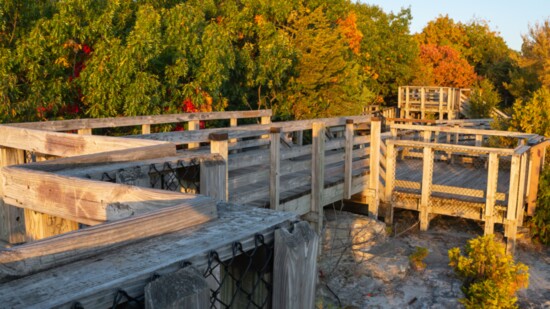Known for its magnificent rock formations of St. Peter sandstone, Starved Rock State Park is a real gem along the banks of the Illinois River just east of Oglesby in LaSalle County (a short 90-minute drive from Lake County).
This is indigenous sacred ground. In the 1760s, Chief Pontiac of the Ottawa tribe, was attending a tribal council meeting. At this council of the Illinois and the Pottawatomie, Chief Pontiac died at the hand of an Illinois-Peoria brave, and Pontiac’s followers sought revenge. A battle started. The Illinois retreated to a great rock on a bluff high above the Illinois River. It proved to be a fatal error. The Pottawatomie warriors encircled the rock, cutting off all avenues of escape, and the remaining Illinois tribal members died of starvation.
After changing hands several times, the property was eventually sold to a developer in 1890 who carved out a vacation getaway with a hotel, dance pavilion and swimming area. In 1911, the State of Illinois purchased the site to convert it to the state’s first recreational park. In the 1930s the Civilian Conservation Corps created camping areas, trails and a lodge that still operates today.
North Barrington’s Maria Peterson considers Starved Rock a peaceful getaway for hiking the trails, and seeing majestic rock formations, waterfalls and canyons. “I love hearing the rustle of leaves on the ground as squirrels and chipmunks scurry to chase each other, and when looking up into the sky, seeing hawks circling to catch their prey,” she said. “Most importantly, it gives me uninterrupted time to be with my family, to be fully present to them and with them. Only an hour-and-a-half away, I love visiting Starved Rock.”
Peterson, a former attorney with the U.S. Department of Labor, is a long-time community advocate currently running to represent the 52nd District of the Illinois State House. Closer to home some of her favorite places to visit are Grassy Lake and Lakewood Forest Preserve. “I believe that funding and maintaining open spaces, such as Starved Rock, Grassy Lake, and other places in nature are important for the people of Illinois. Natural spaces are essential investments in our health, environment, and quality of life.
“Visiting these types of places gives people a sense of stewardship or responsibility to take care of these natural spaces, not only for themselves, but for their children and future generations,” she said. “Clean air and water, flora and fauna cannot survive by us standing on the sidelines. The first-hand experience of breathing, feeling and seeing what is at stake, helps build the community needed to preserve natural spaces and respect the land that we thrive on. They are essential investments in our health, environment, and quality of life.”
At Starved Rock there are more than 18 miles of trails to explore. With names like “Council Overhang,” “Sandstone Point,” “Eagle Cliff” and” “Giant's Bathtub,” there are lots of places to walk in the woods and be inspired.
Based on the time of year, more than 14 seasonal waterfalls reward hikers with splashing, sparkling displays. Hikes through towering sandstone canyons put visitors in touch with a period of time dating back millions of years.
A trip to Illinois’ most visited state park begins by exploring DNR.Illinois.gov/Parks/Park.StarvedRock. Here you’ll find information about hiking, boating, accessibility and more. There’s even the historic Starved Rock Lodge with a variety of options and amenities for guests staying overnight.
About the Park: In 1966, Starved Rock State Park was named a National Historic Landmark. The Lodge at Starved Rock State Park was listed on the U.S. National Register of Historic Places on May 8, 1985. The lodge dates to public works projects that put people to work in the post-depression era of the 1930s. More recently hotel rooms were added, and the entire property is lovingly maintained for the enjoyment of both overnight and day visitors.
